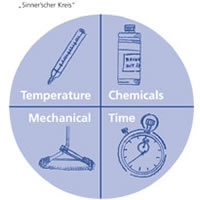Cleanroom Cleaning Systems

Illustration of "Sinner'scher Kreis":
Chemical
First the cleaning process is initiated through the help of active agents in the detergent. Active agents ensure that the bonding forces are neutralized, so that the loose contaminants as well as the bonding contaminants can be removed. The water content serves in this regard as a carrier substance for transporting the contaminants.
Time
This factor represents the period between the application of the detergent or the cleaning bath and the take up of the dirt bath. In cleanrooms this factor can be almost disregarded, because on the one hand, a far lesser accumulation of dirt can be expected compared to industrial flooring: on the other hand, based on the surface condition, often the wet wiping method is used for cleaning.
Temperature
Certain types of contamination can be more effectively loosened with warm water rather than with cold water.
Mechanical
Through the use of optimal mechanical action, it is possible to reduce the start up time and thus accelerate the cleaning process. This factor can be disregarded based on the "low" contamination. Only a manually attached mechanical action is employed with the wiping process to keep possible particle generation or turbulence as low as possible.

Bucket Systems - Stainless Steel
Single- and double-bucket systems made from stainless steel. Accessories are completely autoclavable. Mop and mop frame available.

Bucket Systems - Plastic
Single- or double-bucket systems made from high quality, sturdy plastic (polypropylene).

Mop Systems
Such as isolator tools, mop covers, over under accordion handles, curtain cleaners.

Waste Bins
Hand or pedal operated stainless steel models.